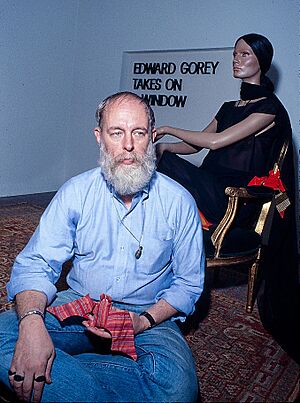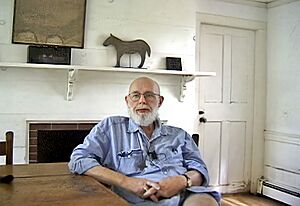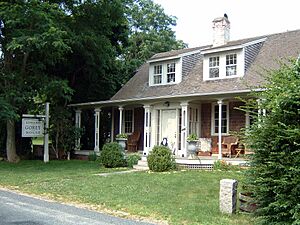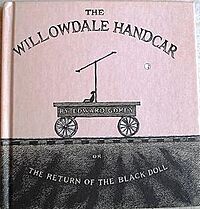Edward Gorey facts for kids
Quick facts for kids
Edward Gorey
|
|
|---|---|

Gorey setting up mannequins in Henri Bendel's window, 1978
|
|
| Born |
Edward St. John Gorey
February 22, 1925 |
| Died | April 15, 2000 (aged 75) Cape Cod Hospital, Hyannis, Massachusetts, U.S.
|
| Education | Art Institute of Chicago, Harvard University |
| Known for | Writer, illustrator, poet, costume designer |
|
Notable work
|
The Gashlycrumb Tinies, The Doubtful Guest, Mystery! |
| Movement | Literary nonsense, surrealism |
| Awards | Tony Award for Best Costume Design Deutscher Jugendliteraturpreis |
Edward Gorey (born February 22, 1925, died April 15, 2000) was an American writer, artist, and costume designer. He was famous for his unique drawings and books. His art often showed slightly spooky scenes from the Victorian era and Edwardian era periods. He also designed costumes for plays, even winning a Tony Award!
Contents
Edward Gorey's Early Life
Gorey was born in Chicago, Illinois. His parents divorced when he was 11 years old. His great-grandmother was a greeting card illustrator. Gorey believed he got his artistic talent from her.
He went to public school in Wilmette, Illinois. Later, he attended the Francis W. Parker School in Chicago. From 1944 to 1946, he served in the United States Army. After that, he went to Harvard University. He studied French and graduated in 1950. He also studied art for one semester at the School of the Art Institute of Chicago in 1943. He often said his formal art training was "negligible," meaning very little.
His Amazing Career
From 1953 to 1960, Gorey lived in Manhattan, New York. He worked for Doubleday Anchor, a publishing company. There, he designed book covers and added illustrations to many books. He illustrated famous works like Dracula by Bram Stoker and The War of the Worlds by H. G. Wells. He also illustrated Old Possum's Book of Practical Cats by T. S. Eliot.
Throughout his life, Gorey illustrated over 200 book covers. He also created artwork for many children's books by John Bellairs.
His first own book, The Unstrung Harp, was published in 1953. He sometimes used different pen names. These names were often anagrams of his own name. For example, he used Ogdred Weary and Dogear Wryde. He also used Eduard Blutig, which means "Edward Gory" in German.
The Gotham Book Mart, a bookstore, helped launch Gorey's career. It became a main place for his work. The store held exhibitions of his art. This helped him become famous around the world.
Gorey's illustrated books often have a slightly mysterious feel. They are set in Victorian and Edwardian times. These books gained a large group of dedicated fans.
He made a big impact in theater too. He designed the costumes for the 1977 Broadway play Dracula. For this, he won a Tony Award for Best Costume Design.
In 1980, Gorey became very well known for his animated introduction to the PBS series Mystery! In this intro, the host Vincent Price would welcome viewers to "Gorey Mansion."
Many people thought Gorey was British because of his art style. But he only left the U.S. once, for a trip to Scotland. In his later years, he lived in Yarmouth Port, Massachusetts. There, he wrote and directed many shows. These shows often featured his own papier-mâché puppets.
After Gorey passed away, a lot of his unpublished work was found. This included complete and incomplete pieces. This means there is enough material for many future books and plays based on his art.
His Personal Interests
Edward Gorey loved the New York City Ballet. He went to every performance for 25 years!
His house in Yarmouthport, Cape Cod, is now the Edward Gorey House Museum. It's a place where people can learn about his life and art.
Gorey left most of his money to a special trust. This trust helps cats and dogs, as well as other animals like bats and insects.
Edward Gorey's Unique Style
Gorey is usually called an illustrator. His books are often found in humor sections of bookstores. However, some of his books, like The Object Lesson, are seen as serious works of surrealist art. He liked to experiment. He made books with no words, books as small as matchboxes, and pop-up books.
Gorey described his own work as literary nonsense. This style was made famous by writers like Lewis Carroll and Edward Lear.
When asked if his work was "gothic," he said that nonsense needs to be a bit "awful." He felt that "sunny, funny nonsense" would be boring. He believed there isn't really "happy nonsense."
Pseudonyms He Used
Gorey loved word games, especially anagrams. He wrote many books using pen names that were anagrams of his own name. Here are some of them:
- Ogdred Weary – The Curious Sofa, The Beastly Baby
- Mrs. Regera Dowdy – The Pious Infant, The Izzard Book
- Eduard Blutig – The Evil Garden, The Tuning Fork
- Dogear Wryde – The Broken Spoke/Cycling Cards
- Madame Groeda Weyrd – The Fantod Pack
His Lasting Legacy
Gorey has become a very important figure in the goth subculture. Events based on his works are popular. These often feature Victorian-style costumes, even though Gorey's characters wore styles from different periods.
Other authors have been influenced by Gorey. Daniel Handler, who writes as "Lemony Snicket," wrote the A Series of Unfortunate Events books. He sent Gorey a letter saying how much he admired his work.
Gorey's influence also reached the music world. The album The Gorey End (2003) by The Tiger Lillies and the Kronos Quartet was a collaboration with Gorey. He sent them many of his unpublished works to turn into songs. Sadly, Gorey passed away before hearing the finished album.
The opening titles of the PBS series Mystery! are based on Gorey's art. They are an animated sequence that captures his unique style.
In his later years, Gorey merchandise became very popular. You could find stuffed dolls, cups, stickers, and posters with his art.
Plans have been announced to make a movie based on Gorey's book The Doubtful Guest.
The online journal Goreyesque publishes art, stories, and poems in the style of Edward Gorey. It's a way to keep his unique artistic spirit alive.
See also
 In Spanish: Edward Gorey para niños
In Spanish: Edward Gorey para niños
Other American cartoonists with a similar mysterious style:
- Charles Addams
- Gary Larson
- Lorin Morgan-Richards
- Gahan Wilson
- Angus Oblong




